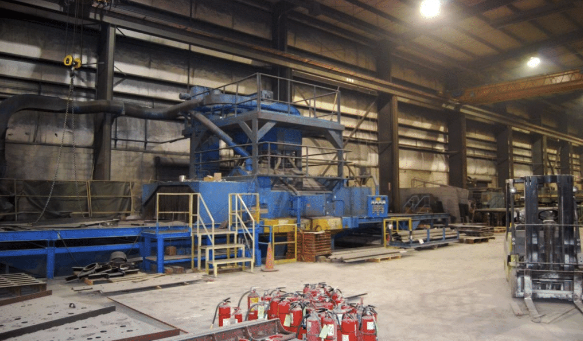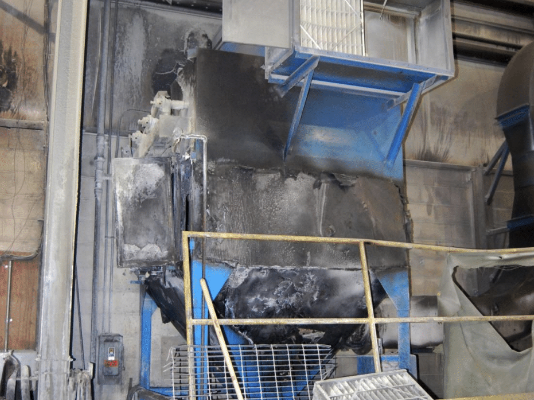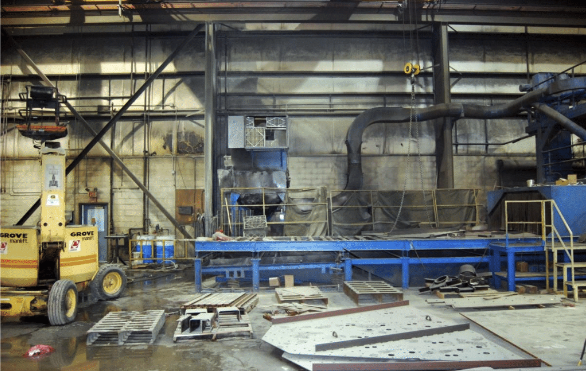A metal dust flash fire in the shot blasting and dust collection area of a steel fabrication plant caused severe burn injuries to one worker and fatal burn injuries to another.
Smoke was discovered being emitted from the dust collector and a man lift was brought into the area to access the filter access doors on the collector. Upon opening the access doors, a worker observed that one of the filters had fallen into the dust hopper below and was burning. The smoldering fire was attacked with portable extinguishers but the fire continued to burn unabated in the lower section of the collector.
After five to ten minutes of unsuccessful attempts to control or extinguish the collector fire, a deflagration in the collector suddenly projected flames out the open door. The flames engulfed both workers on the man lift causing severe burn injuries to one and fatal burn injuries to the other.
The vented deflagration resulted from the ignition of a suspension of steel dust inside the dust collector. The suspended dust cloud was most likely generated by the discharge of compressed air onto the accumulated dust in the dust collector by one of the workers or by the discharge of a fire extinguisher into the accumulated dust.
Discussion regarding metal dust combustion:
The combustibility of steel dust, as with other metal dusts, is highly dependent on particle size distribution and extent of oxidation. The OSHA Tech Center conducted particle size distribution tests that showed that 59% weight % passed through a 200 mesh sieve, i.e. was smaller than 75 micrometers. The OSHA dust combustibility test on the sample produced an OSHA 20-liter low-turbulence Kst (of 2.65 bar-m/s, and a pressure ratio of 2.44. The OSHA lab report conclusion was that the dust sample was explosive, since the pressure ratio was greater than 2 and the Kst was great than 1.5 bar-m/s.
Clouds of combustible dust in an enclosure produce deflagrations when they are ignited when the dust concentration is greater than the minimum explosion concentration (MEC) for a particular material. The MEC depends on dust particle size as well as material composition, with smaller particles having smaller MECs than larger particles have. Typical lower explosive limits for dusts with characteristic particle sizes less than about 100 μm (10-6m) are in the 30 – 60 g/m3 range.
Other parameters are the maximum deflagration pressure in a closed vessel, Pmax, and the Kst parameter defined as:
KSt = (dP/dt)maxV1/3
Where:
KSt = dust deflagration index or dust characterization factor (bar meter/s) where the St stands for Staub, the German word for dust. As the KSt value increases, the dust explosion becomes more violent.
(dP/dt)max = maximum rate-of-pressure rise measured in a test vessel of volume V.
P = Pressure (bar)
T = time (s)
V = volume (m3)
Note: 1 psi = 6.894 kPa,
1 bar ≡ 100 kPa
Laboratory tests are usually conducted in a 20-L spherical vessel per the ASTM E1226 standard. The magnitude of KSt depends on the dust reactivity, the particle size, and the level of turbulence used to generate the dust cloud. Higher turbulence levels produce higher rates of pressure rise.
Most of the damage and casualties in destructive dust explosions occurs as a result of secondary explosions. A secondary dust explosion is caused by dust layers on floors, equipment and structures being dispersed by the blast wave of the primary explosion, and then being ignited by the flame emitted from the primary explosion.





